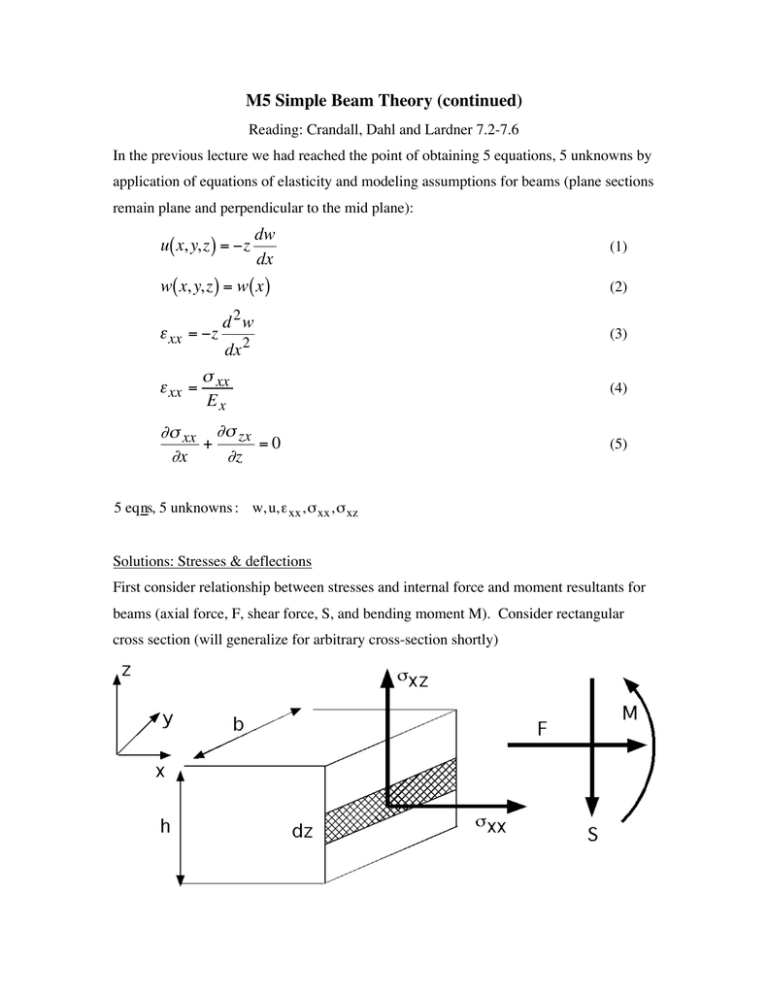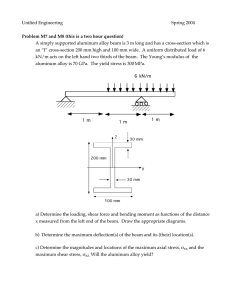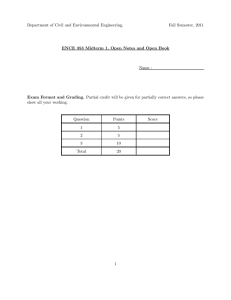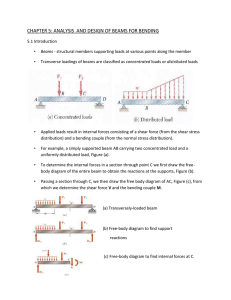M5 Simple Beam Theory (continued)
advertisement

M5 Simple Beam Theory (continued)
Reading: Crandall, Dahl and Lardner 7.2-7.6
In the previous lecture we had reached the point of obtaining 5 equations, 5 unknowns by
application of equations of elasticity and modeling assumptions for beams (plane sections
remain plane and perpendicular to the mid plane):
u( x, y,z ) = -z
dw
dx
w( x, y,z ) = w( x )
†
e xx = -z
†
e xx =
†
d 2w
dx 2
s xx
Ex
∂s xx ∂s zx
+
=0
∂x
∂z
(1)
(2)
(3)
(4)
(5)
†
5 eqns, 5 unknowns : w, u,e xx ,s xx ,s xz
†
Solutions: Stresses & deflections
First consider relationship between stresses and internal force and moment resultants for
beams (axial force, F, shear force, S, and bending moment M). Consider rectangular
cross section (will generalize for arbitrary cross-section shortly)
Resultant forces and moments are related to the stresses via considerations of
equipollence:
h
2
F = Ú s xxbdz
(6)
-h
2
h
2
S = - Ú s xz bdz
(7)
-h
2
h
2
(8)
M = - Ú s xx bzdz
-h
2
Now we combine and substitute between the equations derived above.
combine (3) and (4) to obtain:
s xx = E x exx = - E xz
d 2w
dx2
Now substitute this in (7)
h
È
d w 2
d 2w z2 ˘
F = -E x
zbdz = Í-E x
b˙
Ú
2 -h
2 2 ˙
Í
dx
dx
Î
˚
2
2
h2
=0
-h 2
Which is correct, since there is no axial force in pure beam case.
† Similarly in (8)
+h
d w 2 2
M = Ex
Ú z bdz .
2 -h
2
dx
2
We can write this more succinctly as:
† M = Ex I
d 2w
dx 2
curvature
†
this is the moment curvature relation - positive moment results in
positive curvature (upward). The quantity “EI” defines the
stiffness of beam – sometimes called “flexural rigidity” – note
that it depends on both the shape and the material property, E.
h
2 2
Where I = Ú z bdz is the second moment of area (similar to moment of inertia for
-h
2
dynamics – see 8.01)
† Recall that s xx = -E x z
†
s xx = -
d 2w
dx 2
= -E x z
M
Ex I
This is the moment - stress relationship
Mz
I
Implies a linear variation of stress,
Maximum stress at edges (top and bottom) of beam
More general definition of I :
See Crandall, Dahl and Lardner 7.5
For general, symmetric, cross-section
2
h 2 + y(z)
I yy = Ú z dA = Ú
A
Ú
z 2 dydz
Iyy is second moment of area about y axis.
-h 2 -y(z)
Note that there is also a moment of inertia about the z axis – Izz. In general we will be
concerned about the possibility of bending about multiple axes, and the bending of non-
†
symmetric cross-section. However, we will not consider these cases in Unified (see
16.20)
Note, for particular case of a rectangular section I =
1
bh 3
12
4
[L ]
We need to define centroid: center of area (analogous to center of mass). Position
calculated by taking moments of area about arbitrary axis. Hence z position given by:
Ú zdA
zCentroid = A
No net moment about centroid
Ú dA
A
In bending centroid is unstrained – also known as the “neutral axis” or “neutral plane”
† Can also use parallel axis theorem to calculate second moments of area
I total = Â I i + Â Ai d2i
Second moment
of area about
centroid of area
area
Distance of centroid from total
section centroid
Useful to simplify problems, e.g. for I beam cross-section (structurally efficient form,
effectively used as spars in many aircraft).
is equivalent to:
1
bh 3
12
I total = I y1 y1 + A1d12 + I y 2 y 2 + I y 3 y 3 + A3 d 32
†
Changing area distribution by moving material from the web to the flanges increases
section efficiency measured as I
used.
A
- resistance to bending for a given amount of material
M6 Shear Stresses in Simple Beam Theory
Reading: Crandall, Dahl and Lardner 7.6
Returning to the derivations of simple beam theory, the one issue remaining is to
calculate the shear stresses in the beam. We would like to obtain an expression for
s zx (z ) .
Recall:
Shear stresses linked to axial (bending) stresses via:
†
∂s
∂s xx ∂s zx
∂s
+
= 0 fi zx = - xx
∂x
∂z
∂z
∂x
(5)
and
Shear force (for case of rectangular cross-section, width b) linked to shear stress via:
†
h
2
S = - Ú s xz bdz
(7)
-h
2
Multiply both sides of (5) by b and integrate from z to h/2 (we want to know s zx (z )
Ê hˆ
Ë 2¯
and we know that s zx Á± ˜ = 0 )
†
†
h
2 ∂s zx
Úb
∂z
z
†
†
h
2 ∂s xx
dz = - Ú
z ∂x
bdz
s xx =
-Mz
Iyy
h
h
2 Ê -dM ˆ zb
bs xz (z) 2 = - Ú Á
˜ dz
z
z Ë dx ¯ I
[
]
recall
dM
=S
dx
h
2 Ê zb ˆ
h
˜˜dz
b s xz 2 - s xz (z ) = Ú SÁÁ
I
z Ë yy ¯
( ( )
Note that at z =
†
)
h
(top surface) s zx = 0
2
Also define
h
2
† = Ú zbdz
Q
first moment of area above the center
z
Hence:
†
s xz (z) = -
SQ
I yy b
shear stress -force relation
For a rectangular section:
h
h2
Èz2 ˘
Q = Ú zbdz = Í b˙
ÍÎ 2 ˙˚
z
z
†
2
˘
b Èh2
2
= Í -z ˙
2 ÍÎ 4
˙˚
Parabolic, maximum at z = 0 . The centerline. Minimum = 0 at top and bottom
"ligaments"
For non-rectangular sections this can be extended further if b is allowed to vary as a
function of z. I.e. can write: s xz (z) = -
SQ
I yy b(z )
†
But need to beware cases in which we have thin walled open or closed sections where
shear is not confined to s xz . Will also have s xy (on flanges). E.g.
†
†
or
We will defer discussion of these cases until 16.20.
So this is the model for a simple beam. What can we do with it?
M7 Examples of Application of Beam Theory
Reading: Crandall, Dahl and Lardner 8.1.-8.3
Example: Calculate deflected shape and distribution of stresses in beam. Refer back to
example problem in lecture M3.
Example: Uniform distributed load, q (per unit length, applied to simply supported beam.
Free Body diagram:
Apply method of sections to obtain bending moments and shear forces:
S(x) =
†
qL
- qx :
2
qLx qx 2
:
M (x) =
2
2
†
Let beam have rectangular cross-section, h thick, b wide. Material, Young’s modulus E:
Deflected shape of the beam: obtain via moment curvature relationship:
EI
d 2w
dx 2
= M fi
d 2w
dx 2
=
M (x)
EI
Integrate to obtain deflected shape w(x)
†
w( x ) = Ú Ú
M (x)
dx dx
EI
and for EI constant over length of the beam:
†
fi w( x ) =
1
Ú Ú M (x)
EI
For our case:
†
-qx
(x - L)
2
dw
1 qx
= - Ú (x - L)dx
dx
EI 2
Ê
ˆ
-q È x 3 Lx 2 ˘
Á
= ÁÍ ˙˜ + C1
EI ËÍÎ 6
4 ˙˚˜¯
1 qÈ x 3 Lx 2 ˘
˙ + C1 )dx
So w(x) =
Ú( Í EI 2ÍÎ 6
4 ˙˚
M (x) =
w(x) =
†
˘
-q È x 4 Lx 3
Í + C1 x + C2 ˙
2EI ÍÎ 24 12
˙˚
C1 and C2 are calculated from values of w(x) and w’(x) at boundary conditions.
†
Two constants of integration, need two boundary conditions to solve.
x = 0, w = 0 fi C2 = 0
x = L, w = 0
-L4 L4
-L3
0=
+
+ C1 L = 0 fi C1 =
24
12
24
†
Hence:
w(x) = -
†
†
q
x 4 - 2Lx 3 + L3 x
48EI
[
Maximum deflection occurs where:
†
]
dw(x)
=0
dx
dw
L
fi 4 x 3 - bLx 2 + L3 = 0 at x =
dx
2
†
5 qL4
w=384 EI yy
†
Find Stresses:
s xx = -
Mz
I yy
substitute for M(x)
L
qL2
Max tensile (bending) stress at x = , M max =
, z = ±h2
2
8
s xx max =
†
3qL2
4bh 2
Shear stresses:
† -SQ
s xz =
Ib
occurs where max shear force S =
qL
@ x=0, x=L
2
for rectangular cross-section
h
2
Q(z) = Ú z ¢bdz ¢
†
z
h
È bz ¢ 2 ˘ 2 b È h 2
˘
2
˙ = Í -z ˙
=Í
2 ÍÎ 4
ÍÎ z ¢ ˙˚
˙˚
z
bh 2 qL 12 1 3 qL
=
8 2 bh 3 b 4 bh
†
Note that this is much smaller than s xx
if L/h is large (i.e slender beam).
max
s xzmax =
†
†
M8 Application of Simple Beam Theory: Discontinuous Loading and
Statically Indeterminate Structures
See Crandall, Dahl and Lardner 8.3, 3.6, 8.4
Example
Free body diagram
Shear forces:
Bending moments:
-Mz
= constant for L £ x £ 2L - useful for
I
mechanical testing of materials – “four point bending”
Note in passing M(x) and hence s xx =
Could solve for deflections by writing separate equations for: M(x) for 0 < x < L, L <
x < 2L, 2L < x < 3L and integrating each equation separately and matching slope and
displacements at interfaces between sections. This is a tedious process.
Or we can use:.
Macaulay’s Method
Relies on the knowledge that the integral of the moment (i.e. the slope, and deflection)
are continuous, smooth functions. Beams do not develop “kinks”. This is a particular
example of a class of mathematical functions known as “singularity functions” which are
discontinuous functions, defined by their integrals being continuously defined.
Apply method of sections to the right of all the applied loads
Write down equilibrium equation for section, leaving quantities such as {x-L} grouped
within curly brackets { }
M x=x = 0
M + P{x - 2L} + P{x - L} - Px = 0
{x-a} is treated as a single variable, only takes a value for x > a otherwise { } = 0
Proceed as before - integrate moment-curvature relationship twice, applying boundary
conditions
d2w
M = Px - P(x - 2L) - P(x - L) = EI 2
dx
dw Px 2 P
2 P
2
EI
=
- {x - 2L} - {x - L } + A
dx
2
2
2
Px 3 P
p
EIw =
- { x - 2L }3 - {x - L}3 + Ax + B
6
6
6
apply boundary conditions:
w=0@x=0
w = 0 @ x = 3L
†
for x = 0 only
P( x)3
is evaluated = 0, therefore B = 0
6
PL3 PL3 P
x = 3L fi
- 8L3 + A(3L ) = 0
6
6
6
for
4
fi A = PL2
9
( )
†
˘
1 È Px 3 P
3 P
3 4
2
w(x) = Í
- { x - 2L} - { x - L} + PL x˙ ‹
EI ÍÎ 6
6
6
9
˚˙
Provides complete description of deflected shape of beam in one equation. Can also use
for distributed loads.
†
Statically Indeterminate Beams
Reading: Crandall, Dahl and Lardner, 8.4
(Several ways to approach.)
1.)
By simultaneous application of three great principles
i.e.,
Set up: equilibrium
Moment - curvature
Geometric Constraints
2.)
Solve simultaneously
(reactions remain as unknowns in momentcurvature equations)
Superposition
Decompose problem into several statically determinate structures.
Replace constraints by applied loads
Solve for loads required to achieve geometric constraints.
Example: cantilever beam under uniform distributed load, with pin at right hand end.
RB = ?
Equivalent to:
(1)
+
(2)
From “standard solutions” or calculation obtain expressions for deflections in case (1)
and case (2):
ql 4
d1 = ,
8EI
RB L3
d2 = +
3EI
d1 + d2 = 0
†
fi
qL4 RB L3
=
8EI
3EI
fi
RB =
3qL
8
This is a powerful technique for solving beam problems – statically indeterminate, or
otherwise complex loading.
†
Note. For superposition to work we must be superimposing the loads and boundary
conditions on the same beam. Only change one variable in each loading case.







